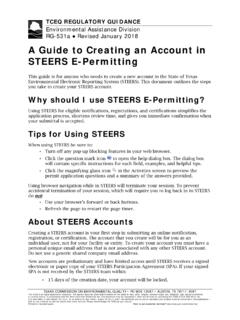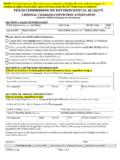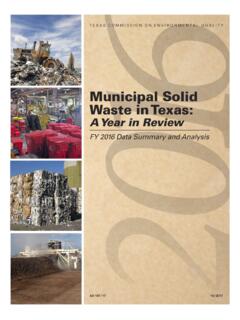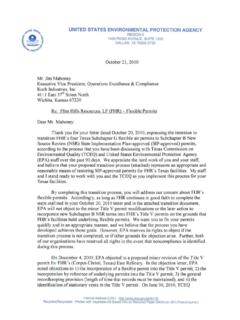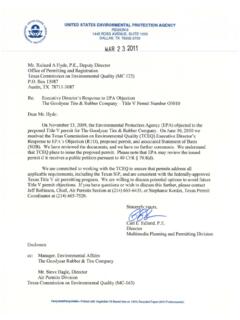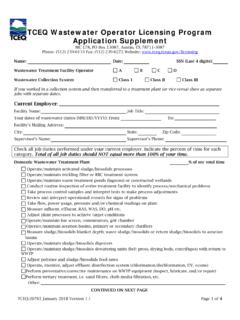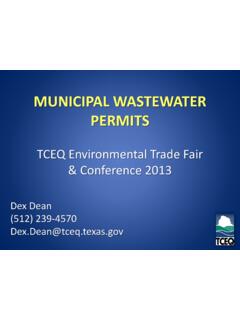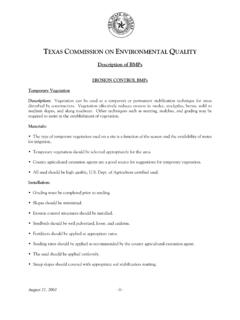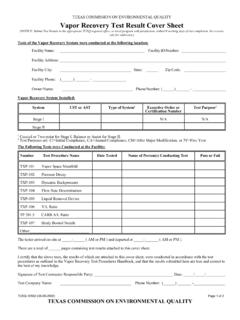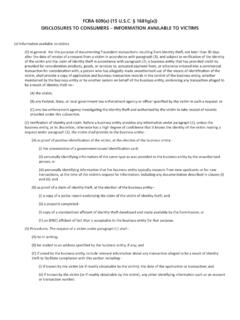Transcription of Investigating and Reporting Releases from Petroleum ...
1 TCEQ REGULATORY GUIDANCE Remediation Division RG-411 Revised August 2012 texas COMMISSION ON ENVIRONMENTAL QUALITY PO BOX 13087 AUSTIN, TX 78711- 3087 The TCEQ is an equal opportunity employer. The agency does not allow discrimination on the basis of race, color, religion, national origin, sex, disability, age, sexual orientation, or veteran status. In compliance with the Americans with Disabilities Act, this document may be requested in alternate formats by contacting the TCEQ at 512-239-0028, fax 512-239-4488, or 1-800-RELAY-TX (TDD), or by writing PO Box 13087, Austin TX 78711-3087. We authorize you to use or reproduce any original material contained in this publication that is, any material we did not obtain from other sources. Please acknowledge the TCEQ as your source. Printed on recycled paper. Investigating and Reporting Releases from Petroleum Storage Tanks Contents Abbreviations and Acronyms.
2 3 Introduction .. 4 Who Should Read This Guide? .. 4 Contact Information .. 4 Where to Get More Information .. 5 Program Overview .. 5 Action Levels .. 5 Release Investigation .. 6 Suspected and Confirmed Releases .. 9 Suspected Releases .. 9 Evidence .. 9 What Action to Take .. 9 Confirmed Releases .. 10 Evidence .. 10 What Action to Take .. 10 Removing an Underground Storage Tank from Service .. 10 Things to Prepare in Advance .. 11 Physical Removal .. 11 Tank Preparation .. 11 Tank Removal .. 12 Sampling .. 12 Tank Transportation .. 12 Tank Storage, Disposal, and Reuse .. 13 Backfilling after Removal .. 13 Abandonment in Place .. 13 Permanent Change in Service .. 13 Report a Registration Change to the TCEQ .. 13 Release Determination and Reporting .. 14 Owner-Operator 14 Assessments at Preexisting LPST Sites .. 15 Release- Reporting Schedule .. 16 Sampling Requirements .. 17 The Importance of Representative Samples.
3 17 When and Where to Collect Samples .. 17 Tank Hold .. 18 Investigating and Reporting Releases from Petroleum Storage Tanks (PSTs) TCEQ publication RG-411 2 Revised August 2012 Piping Trenches .. 18 Dispensers .. 22 Backfill .. 22 Groundwater .. 24 Sampling at Tank Systems Remaining in Place .. 26 Analytical Requirements .. 27 General .. 27 Sample Handling, Analysis, and Reporting .. 27 Custody Seals for PST-Program 27 Before You Mobilize to the Field .. 29 Important Analytical Terms .. 29 Key Items to Discuss with Your Lab .. 29 Analyzing for PAHs and Interpreting the Data .. 35 What to Submit to the TCEQ .. 36 Laboratory Data Package .. 36 Data Review Summary .. 38 Lab Analysis Problems What to Do .. 38 Tables Table 1. PST Release Reporting Schedule Summary .. 15 Table 2. PST Soil and Water Sample Numbers and Locations .. 19 Table 3. Summary of PST Constituents and Analytical Methods for Soil Samples.
4 31 Table 4. Summary of PST Constituents and Analytical Methods for Water Samples .. 33 Table 5. Items to Include in the Release-Determination Report .. 36 Table 6. TCEQ Response Matrix for Analytical Data Issues in PST Release-Determination Submissions .. 40 Figures Figure 1. PST Release Investigation Initial Steps .. 7 Figure 2. PST Release Investigation Release Reporting .. 8 Figure 3. Tank-Hold Sampling: No Water Present, Tanks up to 5 ft in Length .. 20 Figure 4. Tank-Hold Sampling: No Water Present, Tanks between 5 ft and 20 ft in Length .. 20 Figure 5. Tank-Hold Sampling: No Water Present, Tanks Greater than 20 ft in Length .. 21 Figure 6. Tank-Hold Sampling: Water Present (Cross-Section) .. 21 Figure 7. Tank-Hold Sampling: Water Present (Plan View) .. 22 Figure 8. Pipe-Trench Sampling (Cross-Section) .. 23 Figure 9. Pipe-Trench Sampling (Plan View) .. 23 Figure 10. Dispenser Sampling .. 24 Figure 11.
5 Tank-Hold Sampling for Tank Systems Remaining in Place .. 26 Figure 12. Typical Sampling at Tank System Removal (Plan View No Water Present) .. 28 Figure 13. Placement of Custody Seals .. 29 Figure 14. Release Reporting Analytical Considerations .. 41 TCEQ publication RG-411 Investigating and Reporting Releases from Petroleum Storage Tanks (PSTs) Revised August 2012 3 Abbreviations and Acronyms AL action level AST aboveground storage tank BTEX benzene, toluene, ethylbenzene, xylene CAPM corrective action project manager CAS see RCAS COC chemical of concern EPA Environmental Protection Agency IR incident report LOSS licensed on-site supervisor LPST leaking Petroleum storage tank MBTE methyl tert-butyl ether MDL method detection limit MQL method quantitation limit NAPL nonaqueous phase liquid NELAC National Environmental Laboratory Accreditation Conference NFA no further action NOD notice of deficiency PAH polycyclic aromatic hydrocarbon PST Petroleum storage tank RCAS registered corrective action specialist RDR release determination report SPLP synthetic precipitation leaching procedure SDL sample detection limit TCEQ texas Commission on Environmental Quality TPH total Petroleum hydrocarbon USGS United States Geological Survey UST underground storage tank VOC volatile organic compound Investigating and Reporting Releases from Petroleum Storage Tanks (PSTs)
6 TCEQ publication RG-411 4 Revised August 2012 Introduction This document pertains to the requirements for Investigating and Reporting Releases from underground and aboveground storage tanks. It replaces all related guidance previously issued by the Petroleum Storage Tank (PST) Program. Who Should Read This Guide? Environmental professionals seeking release investigation and Reporting information related to the PST Program, including: registered corrective action specialists (RCASs) corrective action project managers (CAPMs) tank contractors (licensed on-site supervisors or LOSSs). The guidance will also help owners and operators understand and oversee release investigations conducted at their storage tank sites, should such activities become necessary. Contact Information Report all nonemergency Releases , both suspected and confirmed, to the TCEQ PST Program in Austin within 24 hours of discovery. The PST Program may be notified by: Phone: 512-239-2200 Fax: 512-239-2216 E-mail: Use the texas Petroleum Storage Tank Program Incident Report Form (TCEQ-20097) for the initial release notification.
7 Fax or mail the completed form to the PST Program. The mailing address is: PST/DCRP Section, MC 137 TCEQ Box 13087 Austin TX 78711 If you are notifying the program by telephone or e-mail, please assemble all of the information on the form before calling or e-mailing. All PST Program guidance and forms are available online at: < > For emergencies such as fire, explosion, or vapor hazards, call the statewide Environmental Release Hotline at 800-832-8224, or call local emergency-response personnel by dialing 911. TCEQ publication RG-411 Investigating and Reporting Releases from Petroleum Storage Tanks (PSTs) Revised August 2012 5 Questions about this document? Call the PST Program at 512-239-2200 or e-mail Where to Get More Information Rules for the PST Program are included in Title 30 of the texas Administrative Code, Chapter 334 (30 TAC 334). All rules can be downloaded from the Web at < > For more information on the PST Program in general, visit < > or call the PST Program at 512-239-2200.
8 Program Overview The texas PST Program is a comprehensive regulatory program for underground storage tanks (USTs), and to a lesser extent, aboveground storage tanks (ASTs). Regulated USTs are subject to extensive administrative and technical standards, including requirements for registration, installation, upgrades, repairs, removals, release Reporting , corrective action, financial assurance, fees, contractor registration, Reporting , and record keeping. Regulated ASTs are subject to registration, fees, release Reporting , corrective action, record keeping, and other Reporting requirements. The statute creating and governing the texas PST Program is texas Water Code Chapter 26, Subchapters I and K. The PST Program regulates USTs and ASTs containing Petroleum or hazardous substances. This guide primarily addresses the most common type of PST release: from a Petroleum UST system. Figures 1, 2, and 14 illustrate release determination.
9 Action Levels The PST Program has established action levels and screening criteria for PST chemicals of concern (COCs), to help determine whether sites must be assigned an LPST number. The action level for a COC is the concentration that, if exceeded, triggers the issuance of an LPST number and further investigation. The action levels for the most common PST COCs, applicable to Releases reported to the TCEQ on or after March 19, 2009, are available online at: < > The action level is the lowest applicable health-based or groundwater protective target concentration for the respective COC. For COCs not listed (for example, hazardous Investigating and Reporting Releases from Petroleum Storage Tanks (PSTs) TCEQ publication RG-411 6 Revised August 2012 substances), contact the PST Program for assistance in determining the appropriate action level. The action levels do not apply and the TCEQ will designate the site an LPST site and assign it an ID number when: surface water is affected or threatened by the release; a water well or surface water intake is affected or threatened; buildings or utilities are affected by vapors; nuisance conditions such as odors, discoloration, or taste degradation of water supplies are known or suspected; or non aqueous phase liquid (NAPL) is present in groundwater.
10 When determining the analytical method to use for the analysis of COCs, the method quantitation limit (MQL) must be less than the action level or the most sensitive standard available method must be used for the COC. If the MQL of the analytical method used is greater than the action level, and the method is the most sensitive standard available method for the COC, then (in most cases) the MQL of that method becomes the action level for the COC. For more information on MQLs, see Analytical Requirements. No action levels are established for TPH under the PST Program, and no LPST ID number will be assigned based on TPH alone. However, the program requires TPH testing to screen for polycyclic aromatic hydrocarbons (PAHs) using method TCEQ-1005 during initial release determination activities. If the laboratory reports any detection of hydrocarbons in the carbon range greater than nC12 (for example, > nC12 nC28, > nC12 nC35), the sample with the highest concentration of hydrocarbons in the > nC12 range must be analyzed for PAHs.
